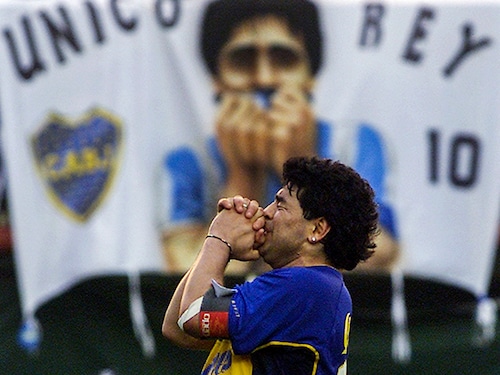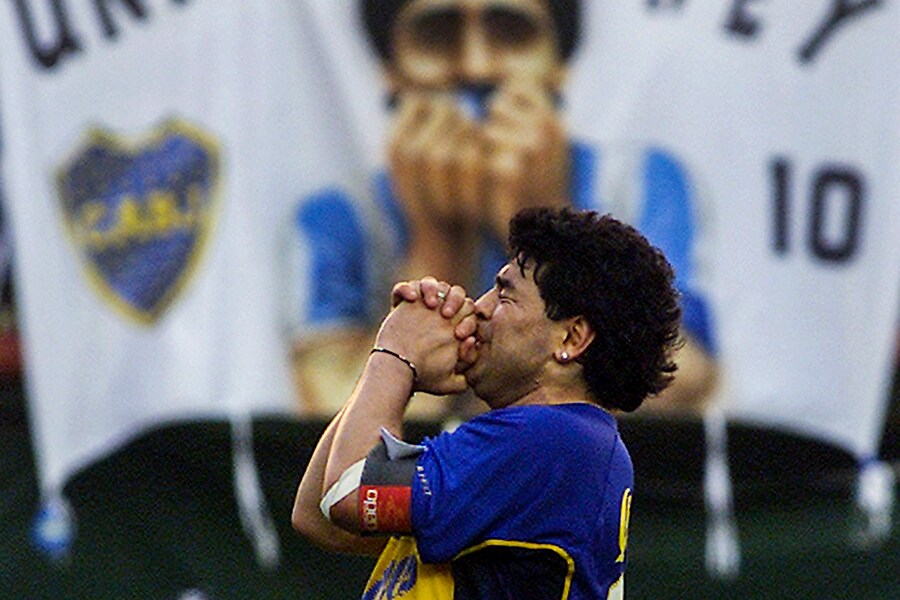Diego Maradona, the most human of immortals
It is certainly possible that Diego Armando Maradona, who died Wednesday at age 60, was the finest soccer player ever to draw breath, though that is a subject of hot and unyielding debate. Less conten


 A file photo shows Argentine soccer legend Diego Maradona (L), wearing a Boca Juniors club jersey, thanking the more than 50,000 fans that watched his farewell match in the Bombonera Stadium in Buenos Aires, November 10, 2001. Maradona remained in intensive care in a Buenos Aires hospital early April 20, 2004, more than 36 hours after falling ill with heart and breathing problems while watching a game at his former club Boca Juniors" stadium where he made his name.
A file photo shows Argentine soccer legend Diego Maradona (L), wearing a Boca Juniors club jersey, thanking the more than 50,000 fans that watched his farewell match in the Bombonera Stadium in Buenos Aires, November 10, 2001. Maradona remained in intensive care in a Buenos Aires hospital early April 20, 2004, more than 36 hours after falling ill with heart and breathing problems while watching a game at his former club Boca Juniors" stadium where he made his name.
Image: REUTERS/Enrique Marcarian
The day that Diego Maradona said goodbye, as his voice cracked and the place that had always been home heaved and sobbed, his mind drifted to the mistakes that he had made, the price that he had paid.
In his valedictory moment, he did not seek absolution. All he asked, instead, was that the sport that he had loved and that had adored him in return, the one that he had mastered, the one he had illuminated, the one he lifted into an art, was not tarnished by all that he had done.
The last line of his speech that day — the final time he graced La Bombonera, home of Boca Juniors, the club that held him closest to its heart — became an Argentine aphorism: “La pelota no se mancha,” he told the adoring crowd. The ball does not show the dirt.
It is certainly possible that Diego Armando Maradona, who died Wednesday at age 60, was the finest soccer player ever to draw breath, though that is a subject of hot and unyielding debate. Less contentious is the idea that no other player has ever inspired such fierce devotion.
There is something approaching a cult in his name in Naples, the overlooked and demeaned port city that he transformed into the center of the soccer universe for a few, glorious years at the peak of his career. The city’s mayor on Wednesday suggested the stadium that houses his former club, Napoli, should be renamed for him. That privilege currently falls to St. Paul.
In Argentina, Maradona’s homeland — which declared three days of national mourning once his death was announced — there has long been a church in his honor. For many, Maradona was a quasi-religious experience.
He was no straightforward icon. He struggled with drug addiction for decades. He was thrown out of a World Cup in disgrace after testing positive for performance-enhancing drugs. Health troubles plagued him, testament to a life of excess. He did not acknowledge his son, Diego, for years. In his later life, he became estranged from his ex-wife, Claudia Villafañe, and from his two daughters, Giannina and Dalma. There were allegations of domestic abuse toward one former girlfriend. There were guns and associations with organized crime.
Maradona never shied away from acknowledging that he had made mistakes, even as he failed to stop making them. The tendency — understandable, sincere, unavoidable — as soccer reeled from the news of his death, as the eulogies flowed from Lionel Messi (“eternal”) and from Cristiano Ronaldo “a genius”) and from Pelé (“a legend”), was to avoid his flaws and his weaknesses, to strike his demons from memory out of respect, out of affection.
And yet without mention of those troubles, Maradona’s story is not cleansed. It is contorted. Those struggles did not improve him as a player. Instead, they would prevent him from achieving all that he might have done and, eventually, shorten his career.
But if the flaws diminished what Maradona was, they burnished what he represented to those who watched him, those who adored him. That such beauty could emerge from such tumult made him mean something more it gave him a resonance that stretched beyond even his outsize ability. His darkness sharpened the contours of his light.
Thirty-two years before Maradona was born, the great Argentine writer Borocotó — editor of El Gráfico, the prestigious, trailblazing sports magazine — suggested the country should erect a statue to the so-called pibe: the dusty-faced street kid with the “trickster eyes,” “a mane of hair rebelling against the comb” and the “sparkling gaze” who represented not only Argentina’s soccer culture, but also its self-image as a nation.
Maradona was the platonic ideal of a pibe, all virtuoso skill and impetuous cunning. He captured the spirit Borocotó made immortal more than any player — more than anyone could have thought possible — not just when he was a teenager, fresh from the potrero, but throughout his career.
All of those iconic images of Maradona are monuments to the spirit of the pibe: leaping high above Peter Shilton, the England goalkeeper, the goal that he would joke — with the “Picaresque laugh” that met Borocotó’s description — was scored by the Hand of God dancing, a couple of minutes later, through the entire England team to score “the goal of the century,” the strike that would prompt the commentator Victor Hugo Morales to declare him a “comet from the sky” facing up to the entire Belgian team, the ball at his feet, a picture of fear on the opponents’ faces.
No matter how high he flew, Maradona never strayed from his roots he was a pibe when he first emerged, he was a pibe when he almost single-handedly dragged Argentina to the World Cup in 1986, and back to the final four years later. He was a pibe when Barcelona made him the most expensive player on the planet and when he took Napoli to not one, but two Serie A titles. He was a pibe even as he conquered the world.
That was his glory, and it was also his downfall. How, after all, could a boy who had never grown up expect to cope with the world he found himself in, with the expectation and the demands, with the idolization and the temptation? The light shone so brightly that the darkness in its wake could only grow.
Maradona himself never made excuses for his missteps, though that is not the same as atoning for them. As he told the filmmaker Emir Kusturica in 2008, he held himself responsible for all that he had done, good and bad. But he knew, too, that at some point a line had to be drawn between Maradona the person and Maradona the player.
His legacy as the former is a complex one: a brilliant, troubled individual, one who suffered pain but inflicted it, too, a boy and then a man who crumbled and cracked under the pressure of a situation he did not have the tools to survive.
But his meaning as the latter is more straightforward. Maradona encapsulated an ideal, he infatuated a nation, he turned a mere game into an art form. The pibe is a quintessentially Argentine complex but it is one that generates global understanding: the impish, improvised brilliance of the innocent.
Maradona himself always saw soccer as his salvation, his deliverance. In 2005, in a brief phase as a television personality, he was asked what he might like to offer up as an epitaph. “Thanks to soccer,” he said. “It is the sport that gives me the greatest joy, the greatest freedom. It is like touching the sky with your hands. Thanks to the ball.”
His flaws and his demons will not be forgotten, not even with time. His memory will always be a complex one. But no matter how deep the darkness, it should not be allowed to obscure the light that he brought. “La pelota no se mancha.” The ball does not show the dirt.
First Published: Nov 26, 2020, 10:25
Subscribe Now